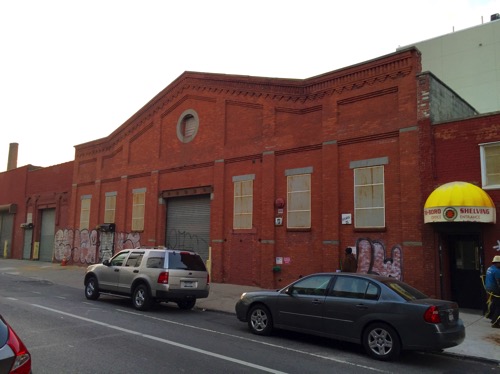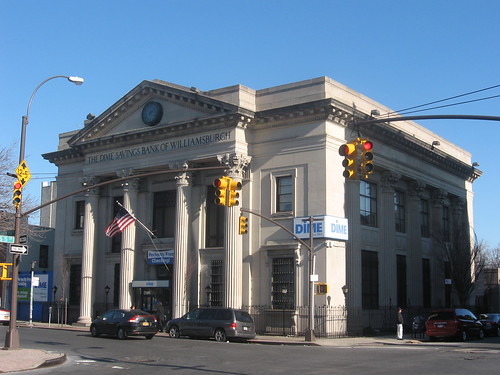Fascinating look at the history of the former St. Denis Hotel on East 11th Street. Jeremiah Moss’ attention to the detail of the history of the building (his office, for a short time longer) is exquisite, as is the history that lies behind the banal pink walls. And speaking of exquisite – that staircase!
The Death and Life of a Great American Building
The Business of Brooklyn: An Amazing History in 20 Artifacts
20 “artifacts” excerpted from BHS’s new The Business of Brooklyn exhibit, including Domino Sugar, Sweet’N Low, Eberhard Faber, Pratt’s Astral Oil works, and Brooklyn Brewery.
Dime Savings Bank to be Landmarked
At a public hearing yesterday, the Landmarks Preservation Commission took another step toward landmark designation for the Dime Savings Bank of Williamsburgh. Among those speaking in favor of designation were the building’s owner and the Historic Districts Council.
The bank building on Havemeyer Street was constructed in 1908 and design by the architecture firm Helmle & Huberty. The building is the second home to Dime (originally they were on Broadway and Wythe). After the construction of the Williamsburg Bridge in 1903, many of Williamsburg’s banks moved from lower Broadway and Grand Street to the newly-created Williamsburg Bridge Plaza. The plaza itself never became the grand public space that one would expect for this era of the City Beautiful and Beaux Arts era, but did become home to a number of monumental buildings, including the Williamsburgh Trust Company, the Dime Savings Bank, Northside Savings Bank and the First National Bank.
It is nice to see Williamsburg get a bit more attention from LPC, but as one of the oldest and most richly layered neighborhoods in New York, we definitely get short shrift. Meanwhile, Manhattan continues to be carpeted with historic district designations.
Dime Savings Bank of Williamsburgh (1908, Helmle & Huberty architects)
[Photo: Matthew X. Kiernan, via Flickr]
So long, 1010 Bushwick Avenue
A lovely Flemish-revival row house on Bushwick Avenue is not long for this world. The building, one of a pair designed by architect Walter B. Wills and constructed in 1915, is slated to be replaced by a 7-story apartment. I’m sure it will be an improvement.
Mixed-use Building for 296 Wythe

296 Wythe Avenue
This makes me sad:
There is currently a one-story factory on each plot. The new owner plans to raze the buildings…
Grand Street: The Williamsburg Divide
Grand Street separates two neighborhoods in Williamsburg, and the Times is on it. The result could be the single worst article ever written about Williamsburg in the paper of record.
Already there is one correction: “An earlier version of this article misspelled in one instance the name of an avenue in Brooklyn. It is Wythe Avenue, not Wyeth”. Presumably another correction will be forthcoming when the Grey Lady discovers that Bedford Street is in Greenwich Village, not Brooklyn. Apparently one does not need to travel to Brooklyn to write about it.
Other than seeing that the Northside is different from the Southside, the whole article hits a discordant note – it is hard to find a paragraph not to object to.
Let’s start with North Williamsburg. Unless you want to appear a rube (or you are a real estate broker), there is no such thing. The streets north of Grand Street are the Northside (and it is one word, not two). There is a South Williamsburg, but it’s not where the Times thinks it is. To locals, South Williamsburg refers to the area south of Division Avenue (in other words south of the numbered south streets). The streets in South Williamsburg are named after signers of the Declaration of Independence, and the area today is largely Hasidic. In between the Northside and South Williamsburg is the Southside (also one word) – the south numbered streets.
The moniker South Williamsburg has been creeping north for a few years now, and I suspect it starts with a real estate effort to rebrand the area away from its Hispanic identity. When South Williamsburg started moving north of Broadway, I asked some Puerto Rican and Dominican friends who grew up in the neighborhood to define the Southside (Los Sures in Spanish). Their boundaries coincided generally with what I had always thought – from Grand Street south to either Broadway or Division, and from Kent to at least Union was the Southside.
To [Northsiders], the south can feel, well, a little too real: a backwater of vinyl siding, dusty bodegas, Gen-Y drifters and unrenovated dumps unfit for civilized company.
I can’t speak to the drifters and dumps, but I do know that the Northside has far more vinyl siding than the Southside (or South Williamsburg). As an architectural historian, to me the Southside is one of the more interesting neighborhoods in Brooklyn, with many readable layers of architecture and culture. The bulk of its low-scale housing stock is pre-Civil War brick houses and flats, reflecting the neighborhood’s history as the original civic and commercial center of Williamsburg (Grand Street was the main commercial artery, which explains why it still has so many great retail buildings). As that center shifted south, so too did development. That explains the large number of late-19th century brownstones and mansions in South Williamsburg, and the great buildings of Williamsburg’s second commercial corridor – Broadway. Both neighborhoods have a lot of architectural gems in the mix (check the AIA Guide, which doesn’t spend a lot of time on the Northside). Meanwhile, the Northside was historically the more working-class neighborhood, and as a result has many more wood-framed flats and tenements, many of which got the vinyl siding treatment in the latter half of the 20th century. The same is true of parts of Greenpoint and East Williamsburg (which, by the way, has been called East Williamsburg for 150 years – no rechristening there).
From architecture and history to restaurants and retail, the Southside is far more interesting than the Northside. I hope it stays that way.
Jailed for 2 Decades in Rabbi’s Death, Unjustly, Prosecutors Say
[David] Ranta was convicted in May 1991 and sentenced to 37.5 years in maximum-security prison, where he remains to this day.
He is almost certainly not guilty.
Sad tale of justice gone completely wrong. Ranta will be set free, but whether any of those responsible for this travesty will ever suffer any consequence seems pretty doubtful.
NYC’s Pneumatic Tube Mail Network
From 1897 to 1953, 27 miles of underground pneumatic tubes looped through the post offices of Manhattan (and out to Brooklyn). Letters too 15 to 20 minutes to travel from Herald Square to the Triborough post office, the northernmost in the system.
I’ve seen remnants of building-wide pneumatic systems, and knew that there was wider service, but never knew it was this extensive (of course, NYC was nothing compared to Paris’ 269-mile system).
Skinny Dennis
Coming soon to the former Barberry/Zipe Zape spot:
The location has operated as a bar since 1939… “These walls have been watching people drink for 70 years,” Mack rhapsodized at the bar’s opening last night. “We’re keeping them for a new generation.”
This bar also used to have a fantastic Deco bar from 1939. Unfortunately, one of the recent owners (but not these guys) tore that out.
PS – no relation.
Change name of Long Island City to LIC, Say Officials, Business Leaders
According to the New York Post, in order to separate from the confusion of being mistaken with Long Island, officials and business leaders are looking to change the name of Long Island City to the “trendier “abbreviation “LIC.”
Maybe part of the reason it is confused with Long Island is because it is part of Long Island. It has been since “L.I.C.” was founded as an independent city in 1870.

